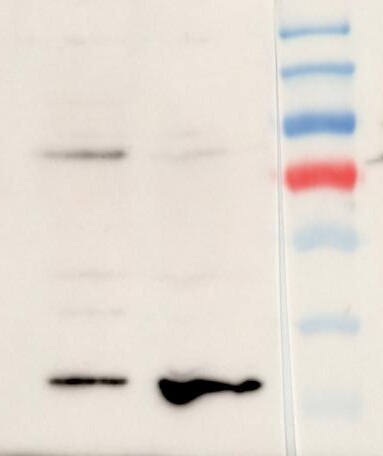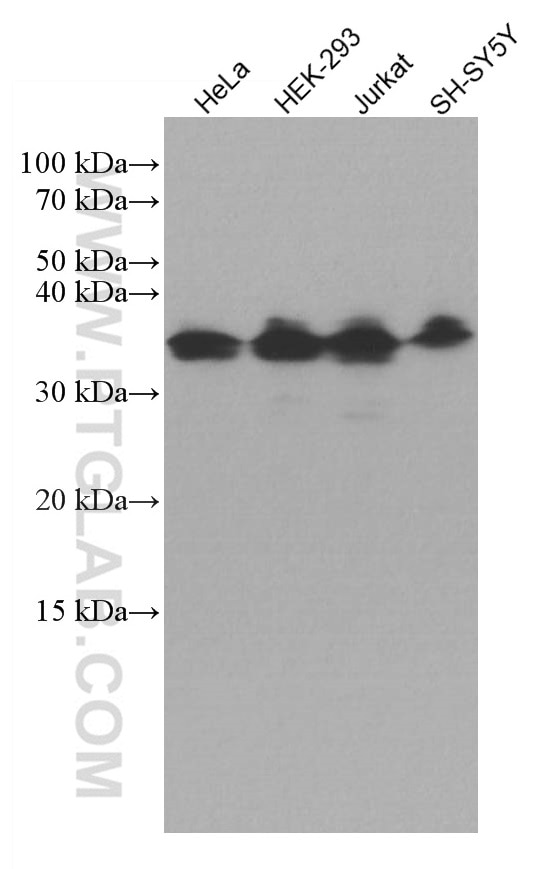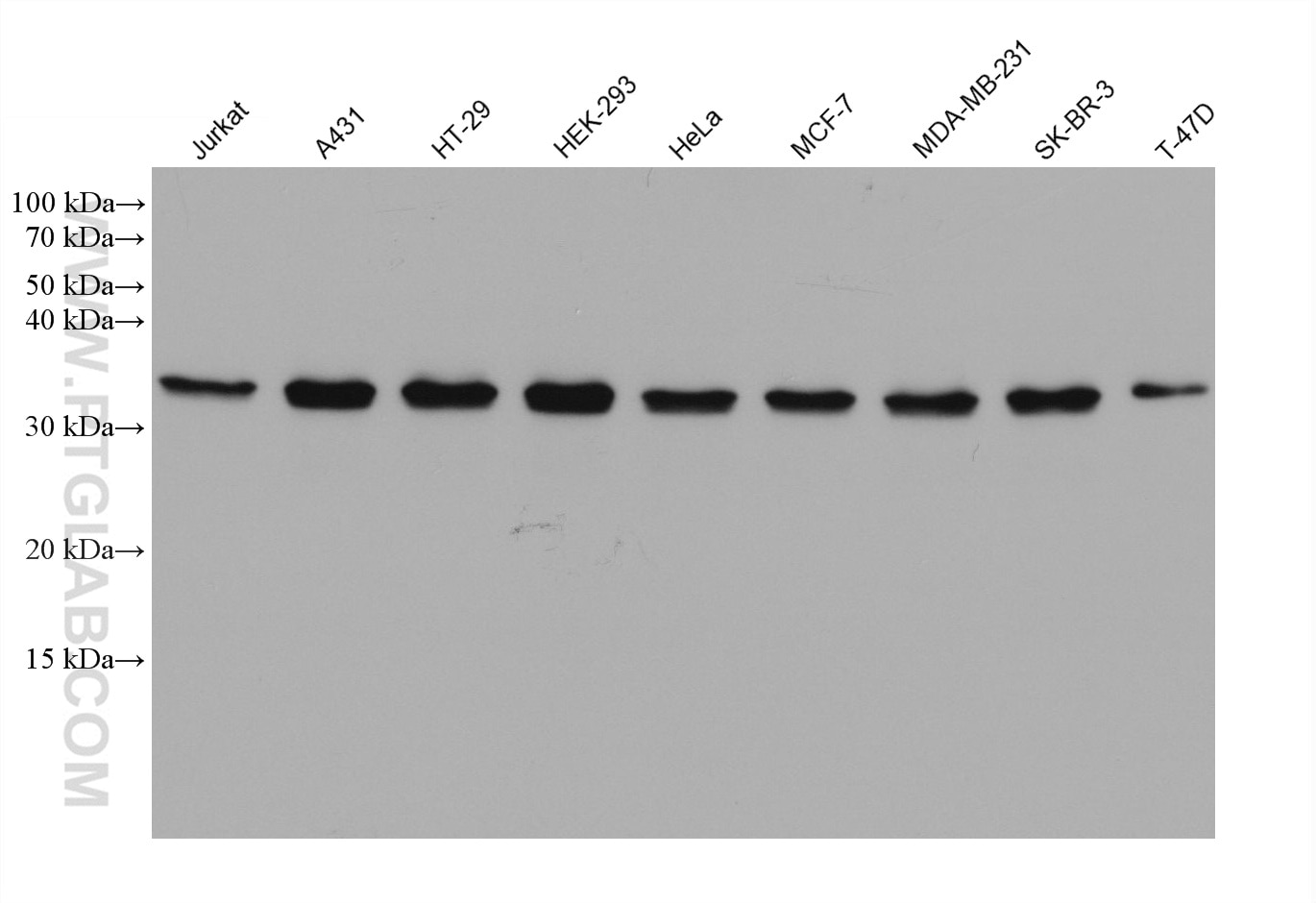Anticorps Monoclonal anti-ATF5
ATF5 Monoclonal Antibody for WB, ELISA
Hôte / Isotype
Mouse / IgG2b
Réactivité testée
Humain et plus (2)
Applications
WB, ELISA
Conjugaison
Non conjugué
CloneNo.
1E5B6
N° de cat : 67066-1-Ig
Synonymes
Galerie de données de validation
Applications testées
| Résultats positifs en WB | cellules Jurkat, cellules A431, cellules HEK-293, cellules HeLa, cellules HT-29, cellules MCF-7, cellules MDA-MB-231, cellules SH-SY5Y, cellules T-47D |
Dilution recommandée
| Application | Dilution |
|---|---|
| Western Blot (WB) | WB : 1:2000-1:16000 |
| It is recommended that this reagent should be titrated in each testing system to obtain optimal results. | |
| Sample-dependent, check data in validation data gallery | |
Applications publiées
| WB | See 5 publications below |
Informations sur le produit
67066-1-Ig cible ATF5 dans les applications de WB, ELISA et montre une réactivité avec des échantillons Humain
| Réactivité | Humain |
| Réactivité citée | Humain, poulet, souris |
| Hôte / Isotype | Mouse / IgG2b |
| Clonalité | Monoclonal |
| Type | Anticorps |
| Immunogène | ATF5 Protéine recombinante Ag7214 |
| Nom complet | activating transcription factor 5 |
| Masse moléculaire calculée | 31 kDa |
| Poids moléculaire observé | 30-35 kDa |
| Numéro d’acquisition GenBank | BC005174 |
| Symbole du gène | ATF5 |
| Identification du gène (NCBI) | 22809 |
| Conjugaison | Non conjugué |
| Forme | Liquide |
| Méthode de purification | Purification par protéine A |
| Tampon de stockage | PBS with 0.02% sodium azide and 50% glycerol |
| Conditions de stockage | Stocker à -20°C. Stable pendant un an après l'expédition. L'aliquotage n'est pas nécessaire pour le stockage à -20oC Les 20ul contiennent 0,1% de BSA. |
Informations générales
ATF5, also named as Activating transcription factor 5, is a 282 amino acid protein, which belongs to the bZIP family. ATF5 is Widely expressed with higher expression levels in liver. ATF5 is actively transported to the centrosome and accumulated in the pericentriolar material (PCM) during G1 to M phase via a microtubule-dependent mechanism. During late telophase and cytokinesis, it translocates from the centrosome to the midbody (PMID: 26213385) . ATF5 as a transcription factor that either stimulates or represses gene transcription through binding of different DNA regulatory elements such as cAMP response element (CRE) (consensus: 5'-GTGACGT[AC][AG]-3'), ATF5-specific response element (ARE) (consensus: 5'-C[CT]TCT[CT]CCTT[AT]-3') but also the amino acid response element (AARE), present in many viral and cellular promoters. Critically ATF5 is involved, often in a cell type-dependent manner, in cell survival, proliferation, and differentiation (PubMed:10373550, PubMed:15358120, PubMed:21212266, PubMed:20654631).
Protocole
| Product Specific Protocols | |
|---|---|
| WB protocol for ATF5 antibody 67066-1-Ig | Download protocol |
| Standard Protocols | |
|---|---|
| Click here to view our Standard Protocols |
Publications
| Species | Application | Title |
|---|---|---|
Nat Commun Moderate-intensity interval exercise exacerbates cardiac lipotoxicity in high-fat, high-calories diet-fed mice | ||
Int J Mol Sci The Mitochondrial PHB2/OMA1/DELE1 Pathway Cooperates with Endoplasmic Reticulum Stress to Facilitate the Response to Chemotherapeutics in Ovarian Cancer. | ||
Toxicol Lett Bavachin induces liver injury and cell apoptosis by targeting Wnt/β-catenin/DRP1 signaling pathway mediated mitochondrial dysfunction | ||
FEBS Open Bio Knockdown of TMEM160 leads to an increase in reactive oxygen species generation and the induction of the mitochondrial unfolded protein response | ||
FEBS Open Bio FAM136A depletion induces mitochondrial stress and reduces mitochondrial membrane potential and ATP production |
Avis
The reviews below have been submitted by verified Proteintech customers who received an incentive for providing their feedback.
FH Morgane (Verified Customer) (09-22-2025) | A couple aspecific bands in higher MW but the corresponding one is much brighter.
 |



